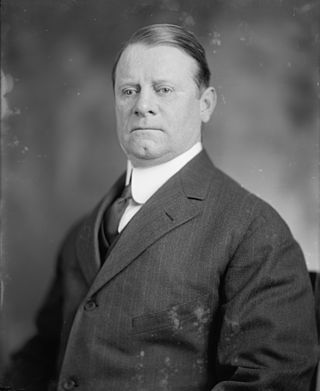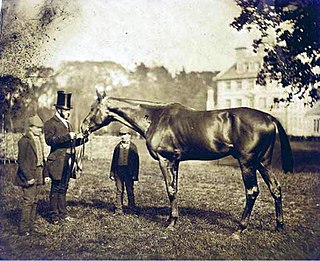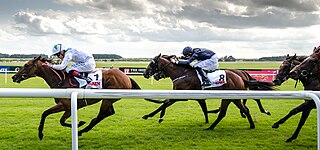Related Research Articles

Arkle was an Irish Thoroughbred racehorse. A bay gelding by Archive out of Bright Cherry, he was the grandson of the unbeaten flat racehorse and prepotent sire Nearco. Arkle was bred by Mary Baker of Malahow House, near Naul, County Dublin, and was born at Ballymacoll Stud, County Meath. He was owned by Anne Grosvenor, Duchess of Westminster, who named him after the mountain Arkle in Sutherland, Scotland, that bordered her Sutherland estate. Trained by Tom Dreaper at Greenogue, Kilsallaghan in County Meath, Ireland, he was ridden during his steeplechasing career by Pat Taaffe.
Peter Simple was the third racehorse in history to win the Grand National steeplechase twice, emulating The Duke and Abd-El-Kader. After winning in 1849 the horse failed to complete the course during the next three years before winning again in 1853 at the age of 15, the oldest ever winner.
Gaylad was a racehorse that beat fourteen rivals to win the 1842 Grand National, ridden by Tom Olliver. It won in a time of 13 minutes 30 seconds.

Gay Crusader (1914–1932) was a British Thoroughbred racehorse and sire who won a wartime version of the English Triple Crown in 1917. In a career which lasted from September 1916 and October 1917 he ran ten times and won eight races, including his last seven in succession. In addition to his three Classic wins he defeated older horses in the Newmarket Gold Cup and the Champion Stakes. Because of wartime restrictions, all of his races were at Newmarket Racecourse. After being injured in training in 1918 he was retired to stud, where his record was disappointing.
The 1838 Grand Liverpool Steeplechase was the last of three unofficial annual precursors of a Handicap Steeple-chase, later to become known as the Grand National Steeplechase horse race which took place at Aintree Racecourse near Liverpool on Monday 5 March 1838 and attracted a field of only three runners. This race did not carry the prestige of the future Grand Nationals and its status as an official Grand National was revoked some time between 1862 and 1873.
The 1840 Grand Liverpool Steeplechase was the second official annual running of a steeplechase, later to become known as the Grand National Steeplechase handicap horse race, which took place at Aintree Racecourse near Liverpool on Thursday 5 March 1840 and attracted a then smallest ever field of 13 runners.

George William Loft was an American businessman, politician, real estate developer, and owner/breeder of thoroughbred racehorses.
The 1842 Grand Liverpool Steeplechase was the fourth official annual running of a steeplechase, later to become known as the Grand National Steeplechase, a horse race which took place at Aintree Racecourse near Liverpool on 2 March 1842 and attracted 15 runners.
The 1844 Grand Liverpool Steeplechase was the ninth annual running of a handicap steeplechase, later to be regarded as the sixth official running of the Grand National Steeplechase, a horse race which took place at Aintree Racecourse near Liverpool on Wednesday 28 February 1844 and attracted a field of 16 runners from a field of 41 entrants. It was won by the 5/1 co favourite, Discount, ridden by John Crickmere.
The 1845 Grand Liverpool Steeplechase was the seventh annual running of a Handicap Steeple-chase, later to become known as the Grand National Steeplechase, a horse race which took place at Aintree Racecourse near Liverpool on Wednesday 5 March 1845 and attracted a field of 15 runners. It was won by the unconsidered outsider Cure-All, ridden by William Loft in a record time of 10 minutes, 47 seconds.
The 1846 Grand Liverpool Steeplechase, later to become known as the Grand National Steeplechase, was the eighth official annual running of a handicap steeplechase. It took place at Aintree Racecourse near Liverpool on 4 March 1846 and attracted a then-record field of 22 entrants. It was won by the unconsidered outsider Pioneer.
Park Top was a top-class British racehorse. She had an unfashionable pedigree, cost only 500 guineas as a yearling and did not run as a two-year-old. Her Grand-dam Oola Hills was the dam of Pappa Fourway, but unlike him, Park Top was at her best over middle distances.
Thomas Olliver, born Oliver or Olivere, was a steeplechase jockey and racehorse trainer who won three Grand Nationals as a rider in the 1840s and 1850s.
William Loft was a farmer and one time steeplechase rider best remembered for his victory in the 1845 Grand National riding Cure-All.
The 1849 Grand National Steeplechase was the 11th official annual running of a handicap steeplechase horse race at Aintree Racecourse near Liverpool on Wednesday, 28 February. It attracted a field of twenty-four competitors for a prize valued at £825.
Fenian was a Thoroughbred racehorse who won the 1869 Belmont Stakes. Bred by August Belmont, Fenian raced as a two-year-old, winning two races, placing second twice, and third once from five starts. As a three-year-old he only raced once, in the Belmont, which he won. He suffered from bad legs and some accounts state that he never raced again after the Belmont, although he appears to have raced later as a gelding, and eventually ended up in England where he did some steeplechase races. His likeness is atop the trophy for the Belmont Stakes.

Isonomy was a British Thoroughbred racehorse and sire. In a career that lasted from 1877 to 1880 he ran fourteen times and won ten races. As a three-year-old he deliberately bypassed the Classics in order that his owner could land a massive betting coup in the Cambridgeshire Handicap at Newmarket. In the following two seasons he was the dominant stayer in Britain, producing a series of performances which led many contemporary observers to regard him as one of the greatest racehorses of the 19th century. He was then retired to stud, where he became a successful stallion.
The 1851 Grand National was, at the time, the 14th renewal of a handicap steeplechase horse race that took place at Aintree near Liverpool, England, on 26 February 1851. However, this was later retrospectively recorded as the 13th official running by the Steeplechase Calendar of 1864 when the race of 1838 was disregarded as official.

Wild Dayrell (1852–1870) was a British Thoroughbred racehorse and sire. In a career that lasted from October 1854 to September 1855 he ran four times and won three races including The Derby. He was an unusual Derby winner, as neither his owner nor his trainer had any previous experience of Thoroughbred racing. Wild Dayrell was retired to stud at the end of his three-year-old season, and had some success as a stallion, siring several good winners.

Horse racing in Ireland is intricately linked with Irish culture and society. The racing of horses has a long history on the island, being mentioned in some of the earliest texts. Domestically, racing is one of Ireland's most popular spectator sports, while on the international scene, Ireland is one of the strongest producers and trainers of Thoroughbred horses. The Irish horse racing industry is closely linked with that of Great Britain, with Irish horses regularly competing and winning on the British racing circuit.
References
- Taken from an article published in 'The Field' magazine August 1974 from an original article written circa 1890s